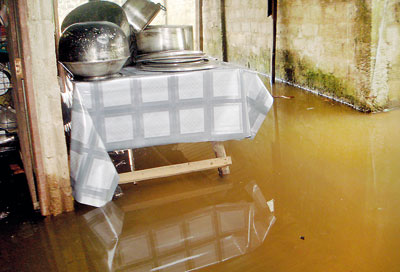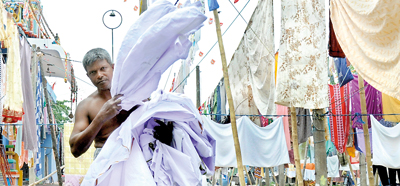The way we were
After the endless stream of noisy crowds for weeks, a silence engulfs the area, disturbed only by a bird-call or the soothing rustle of leaves as rainwater from the massive rock outcrop falls on to tree canopies and slides down.
Just being here at Pahiyangala, off Bulathsinhala, in Kalutara transports us back in time when, surrounded by dense rainforest, a deeper silence would have prevailed without, while under this rock shelter would have been a hive of activity.
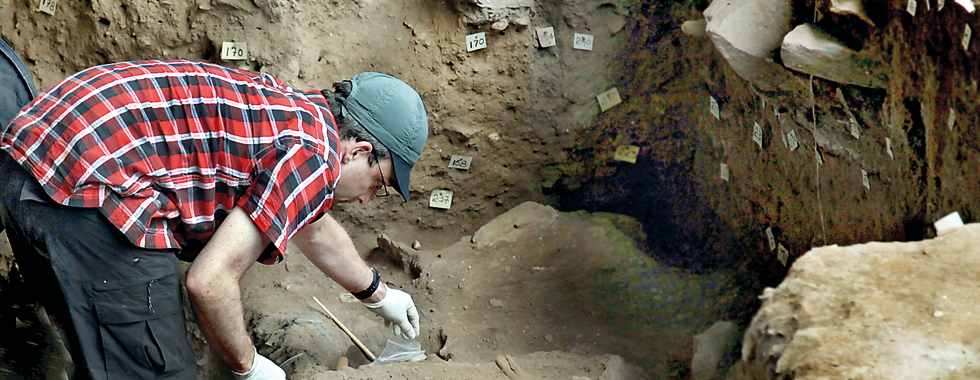
Hard day’s work: The bio-anthropologist from Cambridge uncovering secrets of prehistoric times
Here Balangoda Man, the popular name for Mesolithic humans of Sri Lanka (prehistoric Homo sapiens sapiens), would have lived their daily lives. As hunter-gatherers they would have got their vegetables, yams and fruits off the trees and plants and their meats from whatever animals that lived in their area. They would have lived, loved, squabbled, had children and died, like the humans of today.
Slowly and meticulously in the past few days, a bio-anthropologist from Cambridge, Dr. J. Stock has been squatting from morning till the shadows lengthen, in the pit excavated by the Department of Archaeology surrounded by a local team of experts, headed by Director (Excavations) Dr. Nimal Perera. With gloved hands, the foreign expert is using a small brush to dust off important “findings”, wrapping them in aluminium foil, packing them in bags to be sent to international laboratories to cast light on the latest discovery at Pahiyangala’s smaller rock shelter. It’s only once in a long while that he stretches his limbs after intense concentration.
The latest from the Pahiyangala dig, unearthed several weeks ago by Prehistoric Excavations Research Officer, W.M.C. Oshan Wedage and his team, is a full skeleton of a woman in the age-group 20-30 years having the anatomy of Modern Man, from Mesolithic times. In Sri Lanka, the Mesolithic Period is believed to be from 40,000 to 4,000 years before present (BP) by a former Archaeology Director-General (DG), Dr. Siran Deraniyagala whose speciality is Prehistoric or Ancient Man.
The Pahiyangala human is South Asia’s oldest source of bio-anthropological information, it is learnt.
The Pahiyangala humans would have lived in challenging times, points out Excavations Director Dr. Perera going into their lifestyle. For, Pahiyangala is within a tropical rainforest and in ancient times food resources would have been meagre compared to the Dry Zone.
Smilingly he explains that those were also times without antibiotics and these humans would have had to face disease as well as accidents and bites of venomous creatures.
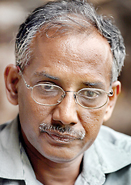
Dr. Nimal Perera
But the Pahiyangala rock-shelters had two major advantages, according to him. They had a lot of light and water was at hand due to a stream that meanders close-by even now. Numerous occupational or habitation deposits have been found here.
“When the men and boys went out hunting, the women and girls would have managed their meals by looking for wild banana (ati-kehel), wild breadfruit (wal-del), wild yams, kekuna nuts and snails for their food,” he says, explaining that these communities had used fire. Earliest evidence of fireplaces at Pahiyangala dates to about 37,000 years.
They also seem to have acquired a taste for salt, most probably adding salt to the meat, Dr. Perera says, putting forward proof in the form of tiny lagoon shells which have been identified from among the wealth of information generated from the Pahiyangala digs.
“The lagoon shells would have come with the salt that they got. But from where did they get the salt? They were nowhere near the coast. So obviously there would have been an exchange of goods with those living along the coast,” he says.
Detailing the process of excavation, Dr. Perera says that at a particular site priority is given to the study of the earth layers containing the archaeological remains. It is this that provides the dating of the finds and their place in the succession of deposits.
So thorough is the team trained by Dr. Siran Deraniyagala over the years that they would bring up only about five buckets of soil a day to look for clues of those times.
“Today, we took out only two buckets,” veteran A.V. A. de Mel tells the Sunday Times last Wednesday, explaining that they then send the soil through a large sieve (sallada), wash it and allow it to dry on racks. Thereafter, they begin the sorting, putting into different heaps the microlithic tools, the faunal and plant remains, the charcoal etc., all the while documenting and labelling each and everything.
“That is the primary sorting,” says Dr. Perera, naming the other Pahiyangala team members as Palitha Weerasinghe, Kamal Nanda, Karunasena, Eregama, Susantha Nihal, H. Jude Perera, P.G. Gunadasa, K.P. Ruwan Pramod and K.P. Sumanadasa and adding that they have been encouraged and guided by National Heritage Minister Jagath Balasuriya, ministry Secretary Kanthi Wijetunge and Archaeological Department Director-General (DG), Dr. Senarath Dissanayake.

Bone tool with serrated edges: One of the significant finds.Pix by M.A. Pushpa Kumara
Thereafter, the different experts will check the specimens, it is understood.Picking out a tiny bone tool which is smaller than 4cms, Dr. Perera is quick to point out that Pahiyangala humans had even serrated its edge, like the bread knives that we use today.
A few more salient points that he deals with are the “behaviours” similar to modern humans. “They had technology in the form of microlithic tools, ornaments such as beads, red ochre pigment perhaps playing a symbolic role, trade with distant places and burial practices.”
With more in-depth study and testing of the findings, the secrets surrounding the Pahiyangala human will be uncovered. Then the truth about the role Sri Lanka played in Prehistoric times may be confirmed.
Finds since 2007
Excavations at Pahiyangala since 2007 have also brought forth:
- Technology that confirms the Mesolithic identity of the inhabitants – geometric microlithic stone tools (usually found rarely, less than one in 100,000 in Sri Lanka) – these would have been used for hunting, butchering, skinning and processing of animals. These microlithic tools were minute geometric-shaped quarts.
- The Balangoda freepoint identified by Dr. Nimal Perera.
- Food habits – that they ate anything which walked, crawled or slithered, ranging from elephants to rhinos to pythons to lizards to molluscs to both fresh water and marine fish. But it was not all meat and fish but also a balanced diet that they consumed including lots of yams, wild breadfruit and Canarium nuts (kekuna). During the excavations begun in February, the researchers have come across shells of land and salt-lagoon snails and bones and other traces of animals, some extinct not only from the area but also from Sri Lanka such as rhinoceros and tigers. Elephant (the teeth of a baby), three types of deer and also leopard are among the other finds. An interesting facet has been the identification of salt-lagoon snails and Tiger-shark teeth. Meanwhile, coprolite (fossilized dung) found at Pahiyangala had been sent to England for testing and found to be that of a carnivore.
- Cultural leanings – the fact that Mesolithic Man was into the arts is obvious, from the use of red ochre as well as graphite for decorative purposes.
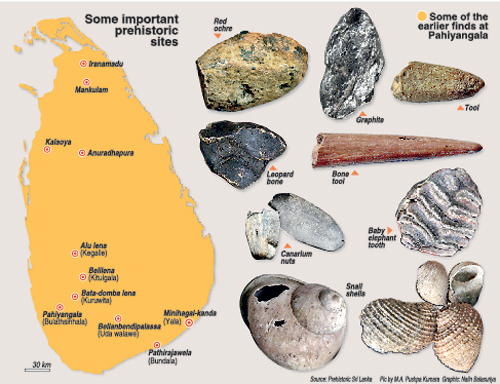 |
















